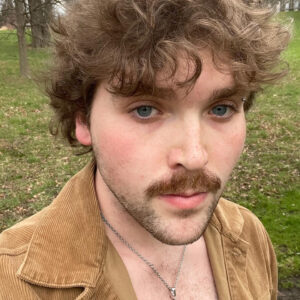“Yiddishland is everywhere.”
This is what Chaia, (she/her), creator of kleztronica – a fusion of klezmer and techno, told me a few weeks after I attended the Yiddish NY Festival Afterparty, the event – described as “where archival Yiddish and klezmer samples combine with racing electronic grooves, drag, disco, and so much more!” – is just one of many performances which Chaia has organized, from rave fundraisers for Palestine to Diasporic Techno Nights. I was set on attending the Kleztronica Afterparty for a few weeks, but I had no idea of what to expect and nor did I have any plans to write about the event. This all changed when I arrived at the venue, DROM, a beautiful bar and lounge in the heart of New York City’s East Village. After checking my coat and gathering myself for the night ahead of me, I felt like I was transported to a different world – the portal to Yiddishland was open, and I jumped in headfirst. Tables fundraising for Gaza, selling Yiddish NY Festival apparel, keffiyehs, and klezmer musician themed lip balm lined the entrance to DROM. When the performances began, I was captivated – I needed to talk to Chaia.
Chaia was inspired to infuse klezmer, Eastern-European instrumental music twinged with Jewish folklore, with the hard and fast beats of techno when she arrived in Boston.
Photo by Julia Hegele
“I found myself getting really involved in the underground rave scene, which was spearheaded by this collective called Clear the Floor, a Black and Indigenous rave collective and through them and also through other musician friends and partners, I started learning about the radical black and queer history of techno.
It clearly resonated to me as a queer person, but also the idea of techno and house music as traditional music that necessitated a cultural space was very similar to the upbringing that I had grown up with.”
Chaia describes seeing many similarities between the Yiddish-speaking queer underground of the late 1960s and 70s with the cultural spaces that rave and techno had created.
“The idea of techno and house music as traditional music that necessitated a cultural space was very similar to the upbringing that I had grown up with. I envisioned the rave, and application and appropriation of black rave music as a way to highlight the most radical aspects of the Yiddish history and culture that I had grown up with.”
Since its inception, klezmer has been a radical tool of Jewish diasporist tradition. It has influences that stretch far and wide, from the valleys in the Carpathian Mountains to the shores of Lithuania – tunes include hymns of the Hasidic niggunim, songs of liberation, and weeping ballads. Klezmer is ultimately a music of exile, constantly adapting and evolving taking on influences from across the Ashkenazi diaspora. Klezmer has survived the Shoah and the harsh Hebraic supremacist policies of the early State of Israel, which tamped down on expressions of diasporic traditions, banning Yiddish periodicals, theater, and music.
Photo by Michael Stitcher
It’s clear that Kleztronica meets the current Jewish progressive movement – the genre embodies some of the radical conversations that are being had across the Jewish community – from Palestinian liberation to the role of gender in Jewish faith. Many young Jews are flocking to Kleztronica and adjacent diasporic spaces – such as The Workers Circle or independent college chaverim – to find communities outside of the performative and hasbarist institutions which dominate the greater Jewish artistic world. Chaia sees Kleztronica as a tool to building stronger connections to the communities we have in the diaspora and as part of a legacy that spans the breadth of Yiddish history.
“When you play traditional music, it breathes an entire world into existence. It breathes certain kinds of stances, certain kinds of buildings, certain kinds of ways in which people interact into existence. These forms are part of a broader way of living Yiddish life and living Yiddish life in sort of a more most radical and participatory and community-based way. It can be lived.”
Kleztronica offers a space in which young Jews, queer and otherwise, can form a community built on liberatory thought, Ashkenazi diasporic traditions, and the joys that come from communal musical celebration. With many Jewish students becoming increasingly disaffected by their Jewish institutions on campus, Kleztronica can act as a gateway to those drawn to Yiddish culture. While the Yiddish speaking world may seem far away from many people, once you are in it, a whole world opens up for you. Chaia discussed the ways students can enter these worlds and how to find your place in Yiddishland.
Photo by Pixeljournalism
“I would encourage people to look beyond their campuses or look through their campuses or look within their campuses, but not limit themselves and look instead to the broader Yiddish world, which is both tiny and everywhere. and that’s amazing because once you tap into any sort of outlet of this world, you’re in it. It’s like entering a portal and you’re in this tiny, tiny world that is also in every single place on there.”




